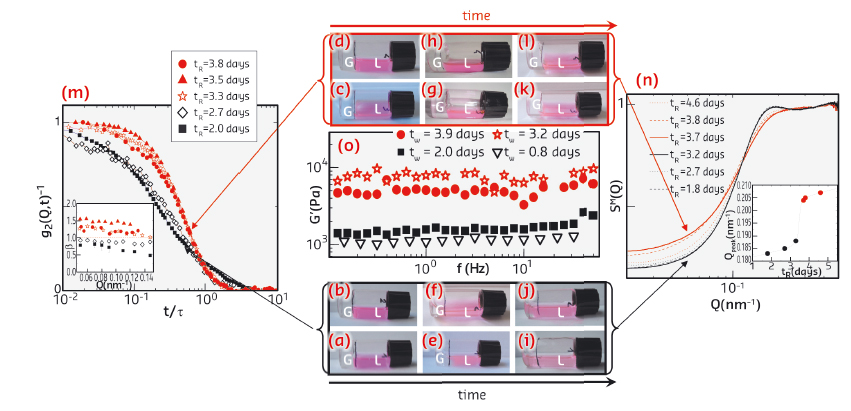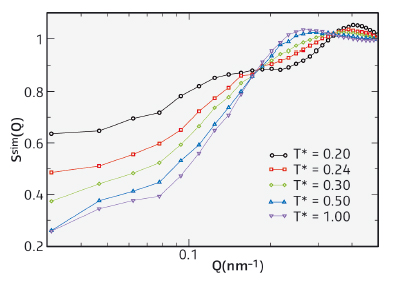- Home
- Users & Science
- Scientific Documentation
- ESRF Highlights
- ESRF Highlights 2014
- Soft condensed matter
- Glass–glass transition during ageing of a colloidal clay
Glass–glass transition during ageing of a colloidal clay
Colloidal suspensions are characterised by a variety of microscopic interactions, which generate unconventional phase diagrams encompassing fluid, gel and glassy states and offer the possibility to study new phase and/or state transitions. Glass–glass transitions in particular have rarely been found, especially at ambient conditions. Here, through a combination of dilution experiments, X-ray photon correlation spectroscopy (XPCS) at beamline ID10, small-angle X-ray scattering (SAXS) at beamline ID02, rheological measurements and Monte Carlo (MC) simulations, we provide evidence of a spontaneous glass–glass transition in a colloidal system consisting of aqueous Laponite suspensions.
Figure 45 shows a dilution experiment that allowed us to distinguish between two different glasses: the first glass melts upon addition of water within three days, i-j, while the second glass no longer melts upon addition of water after three days, k-l. The former is dominated by repulsion, a Wigner glass [1], while for the latter an additional mechanism must have been involved, probably due to attraction [2]. These results suggest that a previously unreported transition occurs in such Laponite glass at weight concentrations Cw = 3.0% around a critical time tc ≈ 3 days.
To further investigate this transition, XPCS measurements were performed on rejuvenated samples and the intensity autocorrelation functions shown in Figure 45m have been fitted through the expression g2(Q,t)-1 = B⋅exp[-(t/τ)β]2 where τ is an ‘effective’ relaxation time whose distribution is measured by the exponent β. Two different behaviours were again observed upon varying the rejuvenation time, tR: samples rejuvenated before tc show a stretched behaviour (β < 1) while samples rejuvenated after tc exhibit a compressed behaviour (β > 1) (inset of Figure 45m) [3].
To complement these observations, we also investigated the structure of rejuvenated samples. Measurements of static structure factors SM(Q) are shown in Figure 45n: two different behaviours were found for samples rejuvenated before tc (black curves) and after tc (red curves) showing a shift of the main peak to larger wave vectors (inset of Figure 45n) and a moderate increase of the low Q signal, that is, of the compressibility.
To gain information on the macroscopic differences between the two glasses, we performed oscillatory rheological measurements at different times before and after tc. Interestingly, a significant change of the storage modulus G’(ν) is found (Figure 45o): for times below 3 days G’(ν) ≈ 103 Pa, however, for times above 3 days, G’(n) is roughly one order of magnitude higher (G’(ν) ≈104 Pa) as found in systems with depletion interactions when passing from a repulsive to an attractive glass. This result thus supports the existence of two glasses with significantly different elastic properties and suggests a crucial role of attraction for the occurrence of the spontaneous glass–glass transition.
 |
|
Fig. 45: (a–l) Photographic time sequence of a dilution experiment for Laponite suspensions at concentration Cw = 3.0% as described in the text. (m) XPCS intensity autocorrelation functions and (n) Static structure factors for rejuvenated aqueous Laponite suspensions at the indicated rejuvenation times tR. In the insets, the β exponent as a function of Q and the peak position as a function of tR are shown. (o) Frequency dependence of the storage modulus G’(ν) at the indicated waiting times tw. |
To clarify the nature of the attraction, we have carried out Monte Carlo simulations of a simple model of Laponite platelets that combines both repulsive and attractive ingredients, see Figure 46. The simulated static structure factor Ssim(Q) of platelets interacting via electrostatic repulsion and a long-range orientational attraction at fixed Cw = 3.0% on varying attraction strength mimics the effect of time taking place in the ageing of Laponite suspensions, producing a qualitative similar behaviour for the structure factors as in the experiments.
 |
|
Fig. 46: Simulated static structure factor of Laponite platelets at fixed Cw = 3.0% with varying attraction strength that mimics the effect of time in the ageing of Laponite suspensions. |
All of the above observations, providing information on the microscopic structure (SAXS) and dynamics (XPCS) as well as on the macroscopic properties (dilution experiments and rheological measurements) and on the microscopic interactions (MC simulations), indicate that two different glassy states are distinguishable with evolving waiting time: the first is dominated by long-range screened Coulombic repulsion (Wigner glass), while the second is stabilised by orientational attractions (disconnected house of cards - DHOC glass), occurring after a much longer time.
Principal publication and authors
R. Angelini (a,b), E. Zaccarelli (c,b), F.A. de Melo Marques (d), M. Sztucki (e), A. Fluerasu (f), G. Ruocco (b,d) and B. Ruzicka (a,b), Nat. Commun. 5, 4049 (2014).
(a) CNR-IPCF, UOS Roma (Italy)
(b) Physics Department, Sapienza University, Roma (Italy)
(c) CNR-ISC, UOS Sapienza, Roma (Italy)
(d) Center for Life NanoScience, IIT@Sapienza, Roma (Italy)
(e) ESRF
(f) Brookhaven National Laboratory, Upton, New York (USA)
References
[1] B. Ruzicka et al., Phys. Rev. Lett. 104, 085701 (2010).
[2] B. Ruzicka et al., Nature Mater. 10, 56 (2011).
[3] R. Angelini et al., Soft Matter 9, 10955 (2013).



